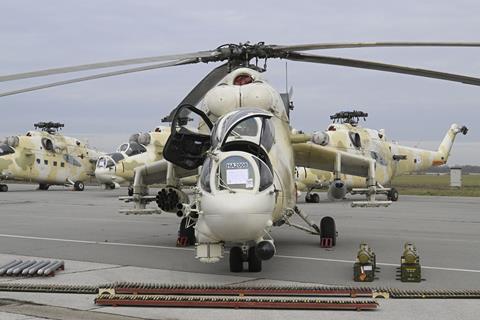Serbia is advancing work to return 11 Mil Mi-35P assault helicopters acquired secondhand from Cyprus late last year to flying condition.
On 1 July, one of the ex-Cypriot National Guard rotorcraft performed test flights from the airport of Utva Aviation Industry in Pancevo, 9.7nm (18km) north-east of Belgrade.
Speaking on 19 November 2023, Serbian President Aleksandar Vucic said “the first six helicopters will fly by the end of January [2024], and the remaining five by the end of summer 2024”.

The apparent delay to this schedule is likely to stem from the complicated export and import processes with Russia for key components requiring overhaul, and from acquiring new avionics and other equipment.
The Mi-35 is subject to heavy maintenance every five years or 1,000 flight hours, whichever occurs first. Prior to their retirement, the Cypriot aircraft had most recently been overhauled in Russia in 2018.
For general overhaul and modernisation work, Serbia uses Batajnica-based maintenance, repair and overhaul specialist Moma Stanojlovic, but this remains highly dependent on Russian industry for items such as engines, hydraulic components and main and tail rotor blades.
Once modernised, Serbia expects the ex-Cypriot aircraft to remain fit for operational use until at least 2036. They will bolster an in-service fleet of four Mi-35Ms that the nation acquired new from Russia in December 2019.

Serbia also acquired air-launched weapons from Cyprus as part of the transfer, including 9M114 Shturm anti-tank guided missiles and S-24 240mm rockets, along with UPK-23-250 gun pods with twin-barrelled GSh-23L cannons. Its aircraft also will deploy 9M120 Ataka-V anti-tank missiles and S-8KOM 80mm rockets.


























